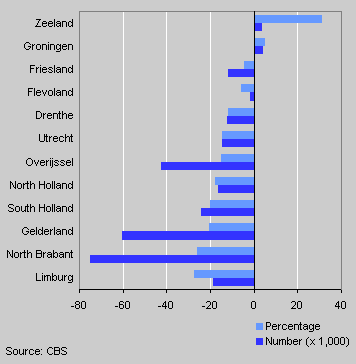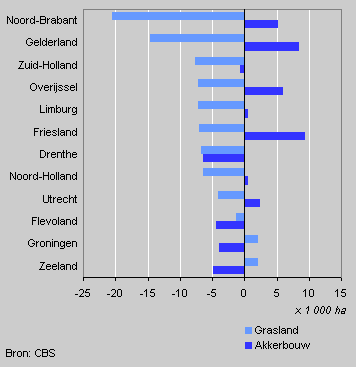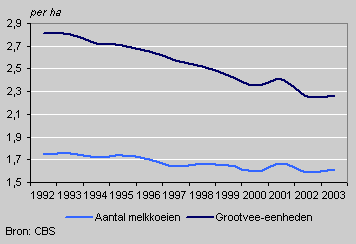More dairy cows in arable areas

The total number of dairy cattle in the Netherlands decreased by more than 15 percent in the period 1993-2003. In the provinces of Groningen and Zeeland, however, two typically arable provinces, the number of dairy cows grew by more than 8 percent. The number of dairy cattle is decreasing most rapidly in Limburg, North Brabant and Gelderland.
Dairy cattle, change 1993-2003

Arable areas
The increase in the numbers of dairy cattle are nearly all in provinces with mostly arable farming. This is probably connected with the fact that in these provinces more land is available to spread the manure produced by the cows. In Groningen and Zeeland, for example, the number of dairy cows rose by nearly 8 thousand in the last ten years. At the same time, the area of grass land in Groningen and Zeeland has increased, at the expense of arable land. In the provinces with most dairy cows, this was exactly the other way around.
Areas of grass land and arable land, change 1993-2003

The numbers of dairy cows have diminished most quickly in Limburg, North Brabant and Gelderland. Dairy farming is still relatively intensive in these areas. In Friesland, Drenthe and North Holland, where dairy farming is still reasonably extensive the decrease is significantly slower.
Friesland is the only typically dairy farming province where the number of dairy cows has risen again slightly in recent years. This is probably because dairy farming in Friesland is reasonably extensive.
Larger scale and more extensive
In 2003 an average dairy farm in the Netherlands had 61 milking cows and 38 hectares of land. Ten years before this was 47 cows and 27 hectares. Dairy farms have therefore become larger overall. Not only that, they have also become more extensive. In 1993 there were 175 cows for every 100 hectares of pasture, in 2003 this was 162.
Land area, number of milking cows per dairy farm

Farmers keeping cows and selling other livestock
The number of large livestock units per hectare on dairy farms has diminished much more quickly than the number of cows per hectare. This means that dairy farmers have achieved their extensive farming methods mainly by getting rid of other livestock than cows, or by buying land.
Dairy cows and large livestock units, dairy farms

Cor Pierik